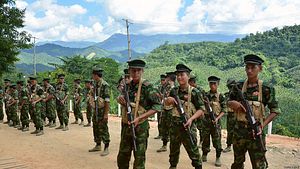Myanmar’s Tatmadaw has been launching air strikes in the gold and mining region inside Kachin state’s Tanai township in recent months. The area is controlled by the Kachin Independence Organization (KIO) and its armed group, the Kachin Independence Army (KIA). The aim is to clear out the illegal mines in the area that provide a lucrative source of income for the KIO.
But underneath this military operation is actually a “resource war” between the Tatmadaw and the KIO in Kachin state. Indeed, control of not only gold and amber but also jade, copper, and ruby mines in the area is important for both the Tatmadaw and the KIO. This competition for natural resources can be viewed as an obstacle to implementing lasting peace in the Kachin state, as it precipitates or worsens the socioeconomic crisis faced by the rest of the Kachin community.
Background
One should refer back to history to understand how an abundance of resources can be a curse rather than an advantage. Kachin state has several ethnic armed groups that hold business assets, particularly in the area of resource extraction, but the main group is KIO. As part of the ceasefire in 1994, the leaders of these groups were co-opted into new patronage networks that allowed insurgent groups to control some territory and natural resources in exchange for their loyalty. However, over time, the ethnic armed groups began to see the Tatmadaw competing with them for control of the resources.
The significance of this competition can be traced back to the early 2000s, when the Tatmadaw’s presence in the area strengthened. The state began to re-route foreign investments through military-state channels by signing deals with foreign investors, banning trade through certain border towns, and redirecting it through Yangon. At that time, the will and capacity of some ethnic armed groups to resist the state had waned.
Nevertheless, illegal gold mining has operated in Hpakant since the 2000s and Lisu people started amber mining in the Tanai township in 2007. The presence of illegal mining strengthens the ethnic armed groups and presents a serious challenge to the Tatmadaw’s attempt to gain control of Kachin state.
As a response, the Tatmadaw decided to conduct clearing operations in the state. Before the clearing operations began, the Tatmadaw dropped leaflets in June 2007 to warn villagers living near the mining areas. It then launched military offensives against key positions of the KIA, effectively breaking the ceasefire in 2011. The Tatmadaw recently managed to seize some gold and amber mining areas from the KIA in the Tanai township.
The Kachin Community
This resource war ignores the socioeconomic crisis that the Kachin community is undergoing. The principal beneficiaries of resource extraction have been a narrow group of ethnic minority elites, regional army commanders, and foreign investors. Competition for control of resources take place particularly between ethnic minority elites and regional army commanders. Meanwhile, the local community continues to suffer from poverty and their livelihood has been affected by the mining activities.
In July 2017, residents of a Kachin village said their farmland had been ruined due to rampant gold mining on the Irrawaddy River in Myitkyina township, Kachin state. The gold mining caused the river’s bank to erode easily when the water level rose. This example illustrates how significant environmental degradation from mining negatively impacted on livelihoods of the local population. Furthermore, none of the proceeds from mining have been reinvested into the Kachin community.
Lasting peace calls for a shift in the nature of the economy in Kachin areas, from the present conflict economy to one that provides broad benefits to Kachin state and its peoples. The patience of the Kachin community is already running out. For example, protesters in Myitkyina township recently held placards reading: “We want equal rights in the mining sector for Kachin people and ethnic citizens.”
However, given the vast sums of money at stake and the extent of the informal trade, ensuring that a share of revenues is reinvested in Kachin state will not be easy. Revenue from resource extraction will continue to line the pockets of army commanders and a small group of ethnic elites in the foreseeable future. As such, the incentive to create a more equitable peace deal would be low.
Broader Peace Project
In the Kachin conflict, the key players are the Tatmadaw and the KIO. Resource extraction has provided incentive and financing for both these groups to continue fighting. In fact, many of the biggest licensed mining companies are controlled by families of politically influential retired generals. An equitable peace deal would mean that the incomes of these companies would be affected. Peace would also slash the incomes of some of the KIO leaders.
It is also unlikely that the National League for Democracy (NLD) government would look seriously into the role of natural resources in fuelling conflict. The NLD’s rule is shaky and the Tatmadaw maintains its “guiding role” in the nation’s politics. State Counselor Aung San Suu Kyi has also chosen to play nice with her former jailers.
Nevertheless, one needs to know that peace in Kachin state goes beyond resolving the military conflict. Socioeconomic issues need to be addressed. Only in doing so can there be lasting peace.
Eugene Mark is a Senior Analyst from the S. Rajaratnam School of International Studies (RSIS) in Singapore.

































